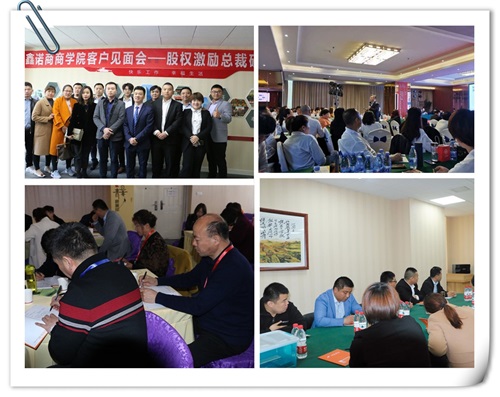
新闻资讯NEWS AND INFORMATION
股权激励方案中的“六定”是什么?
发布时间:2023-12-12 来源:http://www.lushangyun.com/
(一)定人——确定激励对象
(1) Fixed person - Determine incentive targets
定人,即在股权激励方案设计中确定将哪些人作为激励对象,以此确定激励对象的标准。要确定合适的激励对象,需要遵循以下原则:
Fixed person, that is, in the design of equity incentive plans, determine which individuals will be selected as incentive targets, in order to determine the standards for incentive targets. To determine suitable incentive targets, the following principles need to be followed:
其一,一致性原则,即对激励对象采用统一的衡量标准。只有衡量标准相同的前提下,才能确定激励哪些员工是对企业更有益处的。
One is the principle of consistency, which means adopting a unified measurement standard for the incentive target. Only with the same measurement standards can we determine which employees are more beneficial for the company to motivate.
其二,重要性原则,激励对象的选择主要基于重要性原则,需充分考虑激励对象价值,确定符合条件的激励对象。
The second principle is the importance principle, and the selection of incentive targets is mainly based on the importance principle. It is necessary to fully consider the value of incentive targets and determine eligible incentive targets.
在一致性原则和重要性原则的指导下,在确定激励方案时应综合考虑以下因素:
Guided by the principles of consistency and importance, the following factors should be comprehensively considered when determining incentive plans:
1.职级特征:经营班子、核心技术骨干等;
1. Job level characteristics: management team, core technical backbone, etc;
2.司龄特征:公司服务年限及本职工作年限等;
2. Age characteristics: years of service in the company and years of work in the position;
3.历史因素:激励对象为公司贡献的历史业绩等;
3. Historical factors: historical performance contributed by the incentive target to the company, etc;
4.其他特征:学历因素、可替代性因素等。
4. Other characteristics: educational background, substitutability, etc.
在具体的操作中,要综合考虑以上因素,以公司组织架构和管理体系为基础,匡定理想持股人选。
In specific operations, the above factors should be comprehensively considered, and the ideal shareholding candidate should be selected based on the company's organizational structure and management system.
(二)定量——确定激励数量
(2) Quantitative - determining the number of incentives
定量,即在股权激励方案设计中确定用于激励的股份总量及个量。要确定激励的总量,必须得做三方面考量:
Quantification refers to determining the total amount and quantity of shares used for incentives in the design of equity incentive plans. To determine the total amount of incentives, three aspects must be considered:
其一,得考虑企业大股东控制权、业绩目标、企业规模、波动风险的预防,这4个直接影响激励总量确定的关键因素;
Firstly, it is necessary to consider the control rights of major shareholders, performance goals, enterprise size, and prevention of volatility risks, which are four key factors that directly affect the determination of the total incentive amount;
其二,要对股权结构做分析,比如对股权集中程度、原始股东股权激励、股权投资及控制权等做分析,以确定股权激励总额上线;
Secondly, it is necessary to analyze the equity structure, such as the degree of equity concentration, original shareholder equity incentives, equity investment, and control rights, in order to determine the total amount of equity incentives to go online;
其三,考虑动态分配股权模式,即根据公司发展阶段、人才需求、行业变化等情况逐年分次释放,一方面避免一次性分配造成的利益固化,另一方面避免过度激励及过度稀释股权。
Thirdly, consider the dynamic allocation of equity model, which is to release the shares year by year based on the company's development stage, talent demand, industry changes, and other factors. On the one hand, it avoids the solidification of benefits caused by one-time distribution, and on the other hand, it avoids excessive incentives and dilution of equity.
个量的确定由企业根据自身现状和激励对象人数做具体的配比,需要标明个量授予采取的动态方式,规划明确授予时间及节奏,在持续授予激励的同时,做好风险控制。
The determination of individual quantity is determined by the enterprise based on its own current situation and the number of incentive recipients. It is necessary to indicate the dynamic method adopted for individual quantity awarding, plan and clarify the awarding time and rhythm, and ensure risk control while continuously awarding incentives.
(三)定价——确定授予价格
(3) Pricing - Determine Grant Price
定价,即在股权激励方案设计中确定授予激励对象的每股价格。定价是关于利益的心理博弈,得确定企业价值,再次确定每股定价,后要标明购买方式。除此而外,要使得定价结果更科学,在整个定价过程中需要注意以下三个原则:
Pricing refers to determining the per share price to be awarded to incentive recipients in the design of equity incentive plans. Pricing is a psychological game about benefits, which involves determining the value of the enterprise, re determining the price per share, and then indicating the purchasing method. In addition, to make the pricing results more scientific, the following three principles need to be noted throughout the entire pricing process:
1.明确股价的关键影响因素,即每股价格=企业估值/总成本;
1. Clarify the key influencing factors of stock price, that is, price per share=company valuation/total cost;
2.确保“同股同价”,即同一批授予/发行价格应该保持一致;
2. Ensure that "the same shares and the same price", that is, the same batch of grant/issue prices should be consistent;
3.明确大前提,即在公司不亏损情况下,后面的价格比前面的价格高。

3. Clarify the main premise, that is, under the condition that the company does not incur losses, the prices in the later stages are higher than those in the earlier stages.
(四)定条件——确定考核条件
(4) Setting conditions - determining assessment conditions
定条件,即在股权激励方案设计中确定激励对象的考核条件。从企业层面考虑,如果企业整体业绩条件未达标时,则所有激励对象不得行权或解锁获益;如果公司业绩达标时,则所有激励对象满足了行权或解锁的条件之一者,再具体根据个人业绩条件确定是否满足考核要求。于激励对象个人而言,具体授予比例与个人业绩考核结果挂钩。方案设计阶段确切的标明条件,将会避免很多在方案执行过程中可能遇到的阻力与困惑。
Setting conditions, that is, determining the assessment conditions for incentive targets in the design of equity incentive plans. From the perspective of the enterprise, if the overall performance conditions of the enterprise are not met, all incentive objects shall not exercise or unlock benefits; If the company's performance meets the standards, all incentive recipients who meet one of the conditions for exercising or unlocking will be determined based on their individual performance conditions to determine whether they meet the assessment requirements. For individual incentive recipients, the specific award ratio is linked to the individual's performance evaluation results. The precise identification of conditions during the scheme design phase will avoid many obstacles and confusion that may be encountered during the scheme execution process.
(五)定时间——确定授予的具体时间
(5) Set time - determine the specific time of award
定时间,即在股权激励方案设计中确定个量动态授予的具体时间及节奏。在授予过程中可按5+3+2或者4+3+3等节奏采取逐步授予(行权条件)的形式,同时,也可根据激励对象具体的绩效计算其每年应获得的股权数量多少,以按照授予节奏规划授予。
Fixed time refers to determining the specific time and rhythm of individual dynamic grants in the design of equity incentive plans. During the grant process, a gradual grant (exercise condition) can be adopted according to the rhythm of 5+3+2 or 4+3+3. At the same time, the amount of equity that the incentive object should receive each year can be calculated based on their specific performance, in order to plan the grant according to the grant rhythm.
(六)定来源——明确股份来源、资金来源
(6) Fixed source - Clarify the source of shares and funds
定来源,即确定用于股权激励的股份的来源、资金的来源。股权激励即以股权授予激励对象以起到奖励历史贡献者、留住核心骨干、吸引优秀人才的作用,形成企业具有竞争力的人才激励机制。这显然是企业实行股权激励的前置条件。企业股权激励实施是否可行,方案设计中能否明确股权来源,以及来源是否具有可操作性都是很重要的考量因素。
Determine the source, that is, determine the source of shares and funds used for equity incentives. Equity incentive refers to the granting of equity to incentive objects to reward historical contributors, retain core talents, and attract outstanding talents, forming a competitive talent incentive mechanism for enterprises. This is clearly a prerequisite for enterprises to implement equity incentives. The feasibility of implementing equity incentives in enterprises, whether the source of equity can be clearly defined in the design of the plan, and whether the source is operable are important factors to consider.
本站声明
本网站为非营利性网站,旨在宣扬股权知识,交流职业学习心得。网站内部分文章来自其它网站,只做交流学习之用。相应的权力均属于原权 力人,如权利人认为不妥,请来电来函说明,本网站随既停止或使用,谢谢合作! 13698613138
13698613138
微信公众号

扫码获知更多知识

抖音二维码

截屏,微信识别二维码